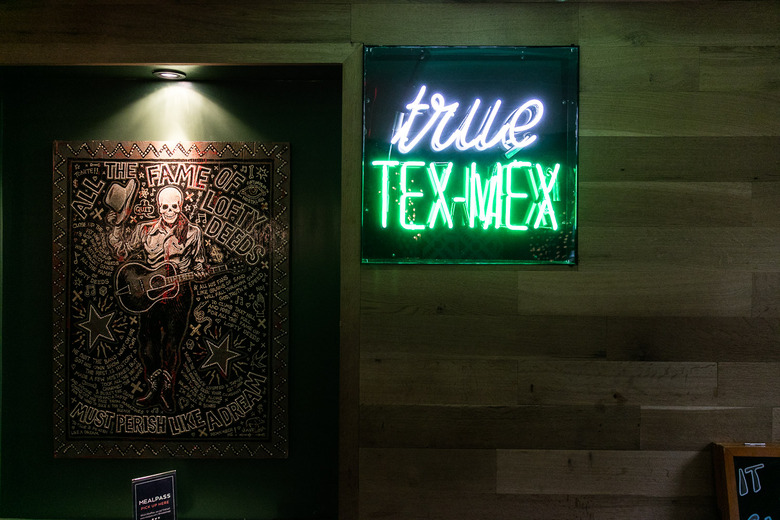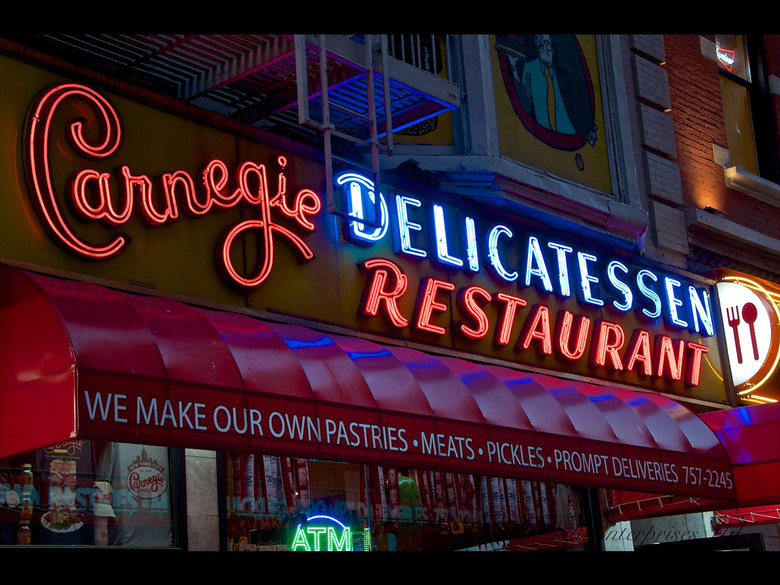Neon Signs Move Into A New Generation Of Cool Restaurants
This April, join us as we take a deep dive into the future of food. Here's where now meets next.
Walk down the streets of a certain part of touristy Midtown Manhattan, and hanging in the windows you'll see flickering signs for diners that never close, ubiquitous big-name beer brands that are aglow and the blue and red letters that call out the Carnegie Deli, their blaze joining the visual cacophony of lights flooding in from Times Square half a mile away.
Many of said neon signs have been hanging there for decades, easy to brush on past without noticing. But once you start to look for neon, it's inescapable. Recently, that is especially true in a particular type of of-the-moment restaurant, where neon no longer hangs outside, designed to beckon to and lure in passersby, but rather more often hangs on the wall as a piece of art, something private to be enjoyed by diners, nostalgic and at the same time edgy and a symbol of a new brand of dining cool.
Enlightened Beginnings
Neon's reputation started off bright: Some time in the early 1920s, a car dealer in L.A. or San Francisco (the details are hotly debated among neon buffs) heard about French inventor and engineer Georges Claude's work: Claude was bending tubes filled with gas to make neon signs. The car dealership owner commissioned a sign from Claude and used it to advertise his business—and the trend caught on quickly, Maggie Zakri, neon historian and collections manager at the Neon Museum in Las Vegas, explains. According to an episode of the podcast 99% Invisible, by the 1930s, there were 20,000 neon advertisements in Manhattan and Brooklyn.
RELATED Your Favorite Restaurant 'Grams: Designed for You "
By the 1950s, though, as people packed up and moved to the 'burbs, "urban decay and neon signs were left behind," Zakri says. Neon's reputation quickly slid from shiny to seedy, from something beautiful and artistic to a symbol of shady bars and bad restaurants and of what was failing. "It happened really fast," she adds. It's a reputation the glowing light has held onto since—until relatively recently.
Bright Lights, Less Gritty
These days, neon is starting to take on new meaning in the restaurant world. It's burning bright in places like high-end cocktail bars in San Francisco and in New York's Aussie import Two Hands, where a pink Ladies sign hangs in the women's restroom, reflected by the white subway-tile walls, and a blue Gentlemen's sign bounces off of black tiling next door. "We wanted the bathrooms to be playful, and neon lights give off a really fun vibe," co-owner Giles Russell explains. "We wanted [them] to be a small nod to New York of yesteryear." It's not an uncommon sentiment among restaurant owners we've spoken to.

The smaller indoor pieces, which generally run from around $1,200 to about $4,000, are more art installation than advertising, explains Jesse MacDougall, the strategy director of design firm ICRAVE, which works with restaurant clients across the country. He says the company has been leaning on neon recently in projects for restaurants, like steakhouse STK, French food court Le District and in other spaces, for "its ability to be used as a pencil stroke. It makes it personal." His colleague, lighting design director Renée Joosten, adds, "It's really like almost anyone can create their own art." Fittingly, Let There Be Neon studio owner Jeff Friedman says more pieces are in handwriting these days, versus the block face of yesteryear—a trend he attributes to the influence of British artist Tracey Emin, whose confessional and highly personal work has often employs neon to write out phrases or quotes.
Given everyone's obsession with the word artisanal at this moment in dining culture, it's also important to note that every single piece of neon is still made by hand. Despite being around for more than 100 years, no one has successfully figured out how to create it by machine. Each piece has to be handmade by a master craftsman who heats the glass tubes over open flames until they're pliable, bending them into letters or shapes and then quickly blowing through a rubber tube to keep them from collapsing on themselves. Cough, sneeze or bend something too far in the wrong direction, and one has to start over.
In Living Color
A growing group of new restaurants is moving away from the stripped-down, polished concrete floors and rough, heavy, rustic-chic wooden tables that have dominated restaurant design in recent years. We're seeing it in vibrant, street art-style murals, graphic menus, electric-colored tables and, yes, neon. "You see color being used exuberantly. I think it's kind of the antithesis of the Brooklynization of restaurants," Ken Fulk says. Fulk has worked on a number of restaurant design projects for Major Food Group, including Sadelle's and recently Carbone in Vegas, which sports a large neon sign that nods to the iconic original one in New York City. "It's the idea of not being afraid," he adds.
Neon fits perfectly into that mantra, although moving it indoors has seen a change in its tone and color—especially when you consider that they're glowing near plates of food. "If you do the right color, it's a warm feeling . . . if you're a high-end restaurant, you want soft colors so you don't need your sunglasses," Pat Tomasso of Manhattan Neon says. "Once you take neon inside, you really want to make sure the color is appropriate," Joosten adds. "Blue light wouldn't look good on your steak." Even with the warmer colors, the signs still have "a high wattage impact," Fulk says.
But it's about more than just the visuals. "[Neon] has an attitude, a swagger. It's a bit more of an F-you that you don't get from other mediums," Fulk says. "Sometimes having a seedy nod isn't a bad thing."
It's a sentiment shared by Friedman, who says neon hasn't entirely shaken off its old reputation, but "that's a good thing, a real good thing. . . . I'd be weary of anything that becomes too safe. . . . We'd much rather piss people off."
Find Sadelle's here, or in our DINE app.
Find Two Hands here, or in our DINE app.
A neon sign "curing" at the Let There Be Neon studio in Manhattan.
Neon makers mark the glass tubes before placing them over the fire.
A "tube bender" as a neon craftsman is called, adjusts the flame on one of his instruments.
Glass tubes are held over open flames to make them bendable into letters and shapes.
Tube benders carefully blow air into the tubes to prevent the sides from collapsing on one another.
Electricity is run through the tubes at high voltage, burning off any impurities inside.
Tube benders work carefully with open flames to adjust the glass.
An almost-finished sign and its maker at the the Let There Be Neon gallery and studio.
A pink eye glows at The Lucky Bee restaurant on the Lower East Side.
Jeff Friedman, who owns Let There Be Neon, also collects and preserves vintage neon signage and clocks.
Customers can pick a color from approximately 90 options.
Let There Be Neon's studio also hosts a gallery of neon art, like these pieces.
The Lucky Bee's phone even has a throwback feel to it.
The Ladies and Gentlemen signs blaze in the restrooms of Aussie restaurant Two Hands.
Green neon and teal walls brighten up Tex-Mex restaurant Javelina.
Pink dominates The Lucky Bee's design.
Carnegie Deli's blue and red neon glows in Midtown. (Photo: Courtesy of Carnegie Deli)
Vintage neon still glows. (Photo: Courtesy of Steam Pipe Trunk Distribution Venue via Flickr)


















